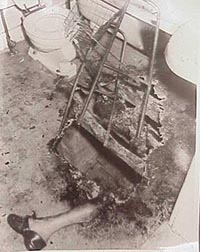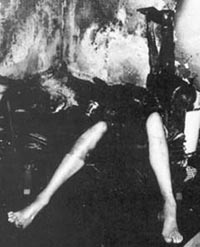Spontaneous Human Combustion

SHC—A Fire Within?
Speculations on the causes of the human inferno called Spontaneous Human Combustion (SHC) include poltergeist activity, ball lightening, vampires, psychic disorders, magnetic storms, microwaves, and the wrath of God. During the mid-nineteenth century, a common belief was that alcoholism was a cause of SHC. Popular writers of the time, such as Herman Melville (Redburn, 1842) Captain Marryat (Jacob Faithful, 1834) and Nikolai Gogol (Dead Souls, 1849), heated up their novels with tales of spontaneous human combustion7, 8.
Most incendiary was Charles Dickens burning of the junk-dealer Krook in the December 1852 installment of Bleak House. Dickens's vivid description of the fire and its aftermath caused George Henry Lewes, a philosopher and critic, to respond to the publication, denouncing it as a "vulgar error" and chastised Dickens and other novelists for perpetuating ignorance and superstition5, 6, 7. Many of today's scientists are inclined to agree with Lewes's opinion.
Scientists believe that explanations for these human infernos are far simpler than SHC, from internal vapors to external accelerants and a plethora of theories abound as to their possible causes.
Theories on SHC
Internal Vapors
Biologist, David Pescod believes that SHC could be caused by a build-up on gases in the body. However, he doesn't believe the fire starts internally. Rather, he theorizes that flammable gases ignite as they mix with air, upon their escape from the body. An article in The Scotsman quoted Pescod as stating, "Although very rare, the breakdown of phosphorous compounds in the body can generate gases in the gut which automatically ignite when they come into contact with air. When the gases escape from the body, they burst into flames.1"
External Accelerants
Research suggests that combustion can be caused by external ignition. Quoted in the same article, another biologist, Dr. Mark Benecke asserted, "Just because an external source of ignition isn't found at the scene, it doesn't mean there wasn't one."

The Wick Effect
Kirk's Fire Investigation, a standard text used in fire forensic work, states that exterior sources such as furnishings, bedding, and carpets are always involved in cases of alleged spontaneous human combustion. It argues that the fat of a burning body can act in similar manner to an oil lamp or candle2. This "wick effect" is a theory endorsed by many SHC researchers.
Murder Most Foul
In March of 2000 at a forensic science conference held in Australia, US scientist John De Haan stated his belief that murder is often involved in alleged SHC occurrences. He explained that an external accelerant generates sufficient heat to sit a body ablaze and melting body fats continue the conflagration after the accelerant has been expended3.
Haan backed up his theory with an experiment he had conducted in a controlled environment. The layer of fat under the skin promotes burning9. Because they are similar to humans in fat content, Haan chose a dead pig as his victim. He wrapped the pig in a blanket, wetted the blanket with a small amount of gasoline and then set it on fire. After five hours, Haan's experiment showed that the pig remains were identical to those found in spontaneous human combustion cases4.
Chemical Reactions
Another theory hypothesizes that chemical reactions involving clothing can cause spontaneous human combustion. In exploring SHC in its television series, "Is it Real?" the National Geographic cited the case of a woman whose clothes suddenly caught fire. A fireworks display on a beach may have covered the area in sodium. A woman collected a shell from the beach and later, put a wet handkerchief in the same pocket as the shell. The TV broadcast offered the explanation that the sodium-covered shell interacted with the moist fabric releasing hydrogen, which then self-ignited5.
So, Is Spontaneous Human Combustion Real?
Dr. Mark Benecke, a forensic scientist as well as a biologist, says no. In his article, Spontaneous human combustion: thoughts of a forensic biologist (Skeptical Inquirer, 1998) he writes, "To my knowledge, no scientific book or article written by a chemist, physicist, biologist, or doctor has ever reported bodies suddenly igniting through some internal but unknown mechanism."
He also asserts that unlike common belief in complete annihilation of the body, in alleged cases of SHC, the internal organs of the victim are usually not "essentially changed" and that in all cases, the internal organs suffer no more damage than the body's exterior, which indicates the fire begins from outside rather than from within.
2. Joe Nickell. “Not-so-spontaneous human combustion.” Skeptical Inquirer 1 Nov 1996. 28 Sep 2008 <http://www.highbeam.com/doc/1G1-18920371.html>.
3. “QLD: US expert bags spontaneous human combustion .” AAP General News 8 Mar 2000. 28 Sep 2008 <http://www.highbeam.com/doc/1P1-25359426.html>.
4. “Spontaneous Combustion.” n.d . 10 Aug 2008 <http://www.mysticalblaze.com/SpontaneousCombust.htm>.
5. Robert Todd Carroll. “spontaneous human combustion.” The Skeptic's Dictionary 2005. 10 Aug 2008 <http://www.skepdic.com/shc.html>.
6. Ellie Crystal. “Spontaneous Human Combustion.” Crystal links n.d . 10 Aug 2008 <http://www.crystalinks.com/shc.html>.
7. Colin Blakemore, Shelia Jennett. “spontaneous human combustion .” The Oxford Companion to the Body. London: Oxford UP, 2001. 28 Sep 2008 <http://www.highbeam.com/doc/1O128-spontaneoushumancombustin.html>.
8. “Spontaneous Human Combustion .” Gale Encyclopedia of the Unusual and Unexplained. The Gale Group, Inc., 2003. 28 Sep 2008 <http://www.highbeam.com/doc/1G2-3406300240.html>.
9. Mark Benecke. “Spontaneous human combustion: thoughts of a forensic biologist. .” Skeptical Inquirer 1 Mar 1998. 28 Sep 2008 <http://www.highbeam.com/doc/1G1-20562402.html>.
